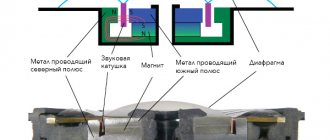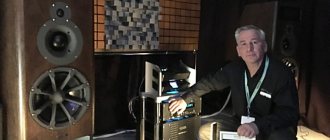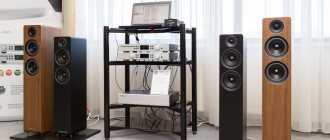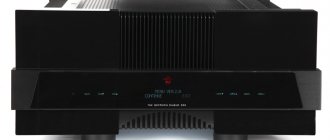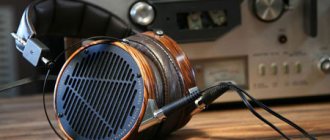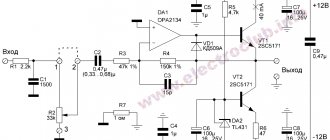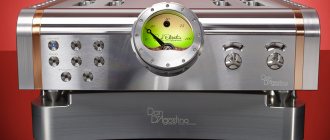Yuri Penkov, DVD Expert, July 2005
Someone compares High End with a religion that preaches blind faith in “musicality,” “transparency,” “space” and other miracles that cannot be measured with instruments. Others suspect that this is a well-planned marketing strategy designed to extract money from wealthy citizens. Still others are convinced that this is the sphere of embodiment of original thoughts and unique technologies.
But what is the High End really like?
We asked Sergei Sorokin, the founder of the Moscow distribution company Hi End Center, a man who has devoted more than 30 years of his life to High End equipment, to answer this (and many other) questions.
Sergey, and yet, what is High End?
Until there is a generally accepted definition of Hi-End, disputes about the content of this phenomenon will not stop. To be fair, it must be said that the term itself was not coined by marketers and PR people, but by the editor of Absolute Sound magazine somewhere in the early 80s. By that time, there was a need not only to give a name to this category of audio equipment, but also to distinguish it from hi-fi.
Let me remind you that hi fidelity is a technical concept that means “high fidelity” and refers to audio and video products whose parameters meet certain standards. Since hi-fi equipment is produced for the mass market by large or even giant companies and corporations, strict quality control and standards are simply necessary. As for small high-end manufacturing companies, they “by definition” manufacture only high-quality products, using expensive components, rare and even unique materials, and manual assembly. And in fact, they set their own standards, which may go beyond the norms adopted for serial audio. The developers in such companies are not just talented engineers with their own individual style, but people who are very receptive to music, as a rule, audiophiles. During the development process, they fine-tune products, changing one or another element or detail and “listening” to what happened. This way they achieve the most natural sound reproduction. High-end components are created to ensure that their sound is as close as possible to live music, and not at all to get good “grades” in the technical data sheet.
The creator of one legendary product puts labels on his products that read: “Do not open or test, plug and listen.” This call is a clear example of respect for listening expertise and skepticism about so-called “objective measurements” that often look good only on paper. Indeed, we still know so little about the world around us, the nature of physical phenomena and human perception, that the desire to “test harmony with algebra” everywhere can easily lead us to a dead end. I, of course, do not urge you to completely ignore technical data, but only strongly recommend that your readers trust their own auditory sensations more. This is the only way to find the High End system of your style and enjoy listening to your favorite music.
Pricing in the High End: a little about the “game” and “manufacture”
It is known that High End audio equipment is “widely” popular, only in narrow circles, and mainly due to its cost. In this article, I analyzed the facts about the nature and history of pricing for this equipment. While writing the material, I discovered several reasons for the relative persistence of the trend. In the material I tried to answer questions such as:
What standards determine whether a device is considered high-end audio? On what basis do manufacturers of such equipment base their pricing policy? What kind of people buy such equipment?
When choosing audio equipment, I am guided by common sense, technical characteristics, my own ears and, of course, economic pragmatism. I came across prices for various types of high-end products directly while working with PULT and was stunned by the number of zeros in the price tags.
I expected it to be expensive, but I couldn't imagine it would be this expensive. Having noticed the ambiguity of the approach to the issue of cost among readers of our blog, I decided to analyze the trends in this segment of the audio market and understand where the legs are coming from.
Standards vs uniqueness
The term “high end” itself still does not have a clear definition and is understood differently by both consumers and manufacturers. Unlike high-end, HI-FI equipment is created in accordance with a number of standards, which are defined by the standards DIN4550, GOST 24388-88, DIN 45500, IEC 60581 and a number of others. At the same time, the vast majority of companies in the Hi-Fi segment keep the quality bar above accepted standards. The standard cannot be called perfection, but it is built on objectively measurable parameters: the minimum value of the unevenness of the amplitude-frequency response (NAF/dB), the coefficient of nonlinear distortion (THD, %), noise level (dB).
As a term for unique equipment for audiophiles, high-end appeared in the 60s, thanks to sound engineer and founder of Stereophile magazine Justin Gordon Holt.
After some time, the term took root and began to mean low-volume or unique equipment created in accordance with the concept of the so-called. "subjective audio". It is also worth noting that before the widespread use of the term, all high-end equipment was labeled as HI-FI. The separation began towards the end of the seventies, when the emergence of the term “High End” in marketing, as a mark for unique products, required a strict separation from mass audio equipment.
Ideology vs marketing: money defeats philosophy
In 2007, Holt, as a sincere person and not too “politically correct,” stated that the principles of High End, both in technical and ideological aspects, were beginning to be profaned, and when asked to give an interview to Audio Magazine, Holt harshly refused, answering the following:
“Over the years, the high end has turned into a “mechanism for conning rich simpletons into something thinner,” I hate even to think about it.”
Having entered into circulation, the ideological term very quickly became a marketing one, defining the positioning of the product. High end was never tied to a technical standard, but emerged as a synthesis of technology and art. In fairness, it should be noted that for some manufacturers the starting ideological paradigm still matters. Meanwhile, the realities of the market and greed did their dirty work; the equipment, which was positioned as high-end, began to cost several times, and sometimes even orders of magnitude, more than any other.
If you do not take into account reputational risks, today, any audio equipment can be “called” high-end and set an appropriate price tag. A very rough hypothetical example: I, armed with a soldering iron, glue, and a manual from a DIY forum, rivet dynamic headphones from a coil, a magnet, paper, wires, a couple of aluminum frames and wooden bowls. I will declare the product high end on the same basis as the vast majority of manufacturers (there is no standard - there is a concept). And my product, from the point of view of the concept of a unique “subjective audio”, will be very high end. Having paid $1000 for the exhibition space, I will present the “project” at some Crocus Expo or VDNKh and perhaps even sell it for 10 times more than the exhibition space and 1000 times more than the cost price. The buyer, based on objective criteria, will never be able to prove that he was deceived and sold non-high-end crap.
On the other hand, a number of manufacturers deliberately set the highest quality bar possible, using high technologies, effective engineering approaches, high-quality expensive components (we are not talking about gold wires and Jurassic capacitors) to create unique, in the good sense of the word, products. It is quite natural that such manufacturers will be guided by the market situation and the price will be beyond the scope of mass-produced equipment. An example is manufacturers of electrostatic speaker systems and headphones, for whom even minimal distortion is critical. However, most people cannot evaluate the quality of such systems due to the exorbitant price.
If we do not take into account metaphysics and marketing myths, the modern ideology of high-end audio can be described as a desire to “disappear” the influence of equipment on sound, which is essentially utopian, but sometimes leads to good results. The latter trend is not true for all manufacturers; many simply prefer to rake in money for mediocre devices with an elaborate design, resistors costing $200, a couple of lamps and gold contacts (I won’t write about cables and TLZ, because the topics are outrageously hackneyed).
In a sense, the high-end industry can be called hostage to marketing, the costs of which also affect the price. The profanation of the values inherent in the original ideology (art and technology in one bottle) is also largely due to inappropriately aggressive marketing. The ritualization of listening to music, the transformation of High End adherents into a kind of sect, pseudoscientific justifications for the astronomical cost of devices and accessories, as well as other obscurantism, are largely the merit of the PR departments of some companies. The contribution of these unprincipled people to “skewed” pricing is one of the most impressive.
Jedem das seine: whatever the child amuses himself with...
From the outside, even with aggressive “religious” marketing, the high end does not look very viable in the modern market.
At the same time, sales of a number of companies, especially those of owners of old and famous brands, remain stable. A reasonable question arises: who buys this and why? Based on my observations, I can distinguish 5 categories of lovers of such equipment.
1.
Very rich people obsessed with status perfectionism. These are the clients for whom marketers have created a prestigious pricing strategy. Often, they don’t care at all how it sounds, sometimes they don’t even visit the showroom, but choose equipment based solely on the price, believing that the most expensive is probably the best. Equipment designed for such a buyer may use expensive types of wood, a fair amount of parts made of precious metals, etc., which automatically increases the already obscene cost of the device.
2.
Audiophiles in an uncompromising search for the perfect sound. Constantly changing devices and searching for a device with the most pure, rich, “airy”, “warm”, “cold”, “bright”, “dull”, “honest”, “highly spiritual” or some other sound (number of subjective criteria may be infinite). Without exaggeration, the search for them lasts throughout one’s adult life or until the resource runs out. In a number of severe cases, a hobby develops into a mental pathology with subsequent accusations against manufacturers, sellers, as well as people who criticize their biased attitude towards quality. They are firmly convinced that there cannot be quality products below a certain price threshold, which makes them similar to the first category and often feeds small but ambitious producers.
3.
Audiophiles with a religious-metaphysical approach to sound. A typical example is Mr.... (however, about those who left, it’s either good or not at all). They believe in the entities inhabiting the equipment, pray to telefunken lamps (or others, depending on the denomination), and develop the concept of the historical authenticity of the equipment. They are extremely hostile to scientific approaches to determining sound quality, believing that a person is able to hear what equipment will never be able to record. They often criticize all modern technology and are ready to give their soul to the devil for some rare model of a DENON turntable from 1900.
4.
People who admire vintage or, on the contrary, futuristic design are often women who buy equipment as expensive toys and eye-catching interior items. As a rule, these are the wives or children of representatives of the first category. They are characterized by a love for hand-assembled devices, various kinds of expensive materials in the design of cases and original designs (stone speakers, glass amplifiers, etc.).
5.
Wealthy people who are critical of the reliability of music reproduction and can afford to spend a significant amount of money to compare equipment and change it like cars. They cannot be called “real” high-end adherents, because: they do not have a “holy” faith in the brand, they do not “warm up” the speakers and wires, and in the selection process they are extremely picky about the quality, but not the price of the device. For them, the term “high end” does not cause the effect of burning eyes; they try to achieve maximum objectivity in their approach. There are few such people, but it’s good that they exist.
One of the prominent representatives of the first wave of the High End movement, the cult audio journalist Ken Kesler, in an interview with stereopravda.ru partially confirmed my conclusions regarding the modern target audience of High End brands. In response to a journalist's question about modern high-end lovers, he stated:
“... So there are only two categories left: these are audiophiles, fanatics of the old school, and simply wealthy people who can purchase expensive high-end out of inertia or for reasons of prestige...”.
As a conclusion
Everyone makes their own conclusion about the adequacy of high-end pricing, and I won’t teach anyone about life. I only recommend comparing the factors that influence the cost of this equipment and paying attention to concise information about the reasons for its purchase and the target audience.
Subjective:
- prestigious pricing strategy;
- active marketing costs;
- brand reputation and history;
- the use of precious metals and expensive materials in design and circuitry;
Objective:
- high quality elements (not always)
- expensive technologies, “no compromise” concept (not always)
- unique effective engineering solutions (not always)
- creative design (a matter of taste)
- manual assembly (not always, a matter of taste)
Why buy
: to search for the “perfect” sound, for high-quality music reproduction, for status show-off, for an expensive interior, for performing ceremonies and rituals.
The target audience
: “seekers” audiophiles with different income levels, music lovers with big money, perfectionists with big money and their family members, the mentally ill.
And yet, in our catalog there is a lot of equipment that manufacturers position as high-end. We formed the catalog in accordance with the needs of clients, their reviews and preferences. In no way do I condemn someone’s choice or refusal to make it, I only describe the facts and share the conclusions drawn.
I sincerely hope for a lively discussion in a positive way.
The position of PULT regarding high-end equipment may differ from the opinion of the author of the material.
Was it this marketing knowledge that helped you implement the “systemic approach”?
Yes, sure. When the Hi End Center was created in 1998, the benefits of a systematic approach for me were undeniable and based on personal experience and observations. I'll try to explain everything.
It is clear that from a commercial point of view, well-promoted brands with powerful PR support from the manufacturing company are the most attractive. All distributors compete for the opportunity to represent brands that are popular on the world market, have high ratings in specialized publications in the USA and Europe, are visible at international exhibitions, and so on. Such products do not require large advertising investments, time, or promotion efforts. Naturally, every businessman is interested in obtaining the greatest profit with the least risk. But is it beneficial to the consumer what is beneficial to the distributor? After all, it happens that a seemingly powerful arsenal of brands is a chaotic collection of famous names, collected without any thought about their compatibility and the possibility of combining them into sets. Clients of such companies have to either choose from the offered assortment or buy components from different places and then combine them into a single configuration at their own risk. Sometimes, dissatisfied with the result, people completely close the topic of expensive equipment. What is the most effective way to solve the problems of those who love music and are interested in purchasing a high-quality system without unnecessary hassle and disappointment?
The company's brand policy should be based on the principles by which a personal hi-end system is formed. Brand products must be effectively combined for better sound reproduction, harmonize in appearance, and the sets made up of them must approach the ideal price/quality ratio. In general terms, this is the essence of the systematic approach that we have chosen for ourselves at the Hi-End Center and are implementing in ours. But not everything is so simple, because to successfully work within the framework of these principles, it is also necessary that the proposed choice meets various tastes, provides opportunities for growth or upgrade within the chosen configuration, and provides everything necessary, starting with the basic components (speaker systems, sources, etc.). ) and ending with cables and accessories. And of course, we must be able to combine and offer different options within the planned budget. By the way, there is another advantageous side of the systematic approach for the client: by purchasing all the equipment in one place, in the supplier’s company showroom, you can always count on good discounts.
Can understanding and perception of High End technology be taught or do you have to be born with it?
The goal of High End Audio is to achieve the most accurate, flawless reproduction of the original musical event. And High End technology is only a tool to achieve it. Ideally, this goal can be considered achieved when the effect of “disappearing equipment” occurs and a direct connection is established between the musician and the listener.
A person who is receptive to music does not need to be convinced of the advantages of High End equipment. He himself is able to distinguish mediocre sound from good. The experience of communicating with clients of the Collection salon shows that most people perfectly hear the difference and even nuances in the sound of systems: they feel harmony and rhythm, correctly perceive the pitch of the sound, and pay attention to the technique of performance. And our task is only to develop the auditory culture, so that a person better understands the intricacies of sound reproduction and consciously perceives consultations on the selection of audio system components.
What are the main mistakes you think people make when selecting components for a home installation?
The most serious and, unfortunately, most common mistake is purchasing components rather than a kit. People buy individual components from different places, often through promotions. It is impossible to assess how compatible they are. The result is a system that is unable to unleash the potential of each device. I am convinced that the right path is, first of all, choosing the right dealer. Visiting specialized salons, communicating with consultants, individual listening - all this will help you decide where and what to buy. In a good High-End salon, auditions are organized based on the assigned tasks and at a time convenient for the client. You need to listen to the system for at least 20 minutes. Usually this time is enough to realize the primary auditory impressions. The sound should under no circumstances be tiresome. The good energy of the system is the first argument in its favor.
Anyone planning a purchase wants to get the best for less money, and the desire to save money is understandable. However, we have to admit: quality things, alas, are expensive. Sometimes, when creating a High End package, we observe the client’s desire to win at all costs. As a result, saving in small things, you can lose in big things. In such cases, we convince people to change their focus and look at High End as an investment rather than a waste. After all, this is truly a long-term investment and not only in material values, but also in your own pleasure and development. Believe me, in the end, the price is forgotten, but the quality remains!
And the last thing I would like to warn against is the “idolization” of brands - blind faith in myths created by marketers. There is no need to get hung up on popular brands. After all, the credo of High End is the search for ways to achieve perfect sound reproduction. And then, what are you paying for: for quality or for the flow of advertising for promotion?
The best way to select equipment is always to personally listen and compare applicants.
More action - less words, review. Pro High End Magazine
Ten years ago, as part of the then recently appeared Azur series, the English company Cambridge Audio first announced stereo devices under the symbol 700. At the exhibition held in Las Vegas in January, this manufacturer got rid of the Audio prefix in its name, updated the logo, and at the same time introduced a new series equipment under the symbol CX
Save and read later -
Ten years ago, as part of the then recently appeared Azur series, the English company Cambridge Audio first announced stereo devices under the symbol 700. At the exhibition held in Las Vegas in January, this manufacturer got rid of the Audio prefix in its name, updated the logo, and at the same time introduced a new series equipment under the symbol CX. It currently includes a CD transport, network player, two full stereo amplifiers and two multi-channel AV receivers. The cost of the new products is slightly higher than that of the classic components of the “six hundredth” series and significantly lower than the flagship “eight hundredth”, so that they can conditionally be considered the notorious “seven hundredth”. We decided to test a stereo package: a CXC CD transport, a CXN network player and a CXA80 complete amplifier.
The transport power supply is built on the basis of a toroidal transformer, and the S3 model, similar to the one installed in the flagship “eight hundredth” series, is used as a drive. The outputs, of course, are only digital, that’s why it’s transport, but taking into account the low cost and switching and functional features of the other components of the series, this decision looks extremely logical.
The player, unlike the transport, is equipped with a pulse power supply, but its signal “filling” is much wider. The LAN9512-JZX controller is responsible for network connections, USB is served by the XMOS controller, and CS8416 is used for digital inputs. In addition to playing file content with a resolution of up to 24/192 from local storage devices and over the network, the device has Internet radio, Spotify, AirPlay and Bluetooth aptX. Removing wireless switching from the basic functionality to the list of additional options (due to a couple of proprietary “whistles”) at first looks somewhat complicated, but then you realize that the notorious “whistles” are much easier to certify than a full-fledged device, hence saving time and money for the end user .
Thanks to Anagram Technologies ATF2 (Adaptive Time Filtering) technology, the source digital stream is converted to a signal with a resolution of 24 bit/384 kHz, and only then converted to analog form using a pair of WM8740 converters. The player is equipped with a 110 mm diagonal full-color display and a remote control: in principle, this is already enough for full control, but if you wish, you can install an application for mobile devices on iOS or Android.
The amplifier's power supply contains a toroidal transformer and a bank of filter capacitors with a total capacity of about 30 thousand microfarads. Traditional digital inputs are handled by the CS8416 receiver, USB is handled by the XMOS controller, and digital-to-analog conversion is handled by the WM8740 converter. In addition, there is the possibility of Bluetooth connection. The signal level is adjusted by a motorized Alps potentiometer, and a pair of Sanken field-effect transistors, STD03P and STD03N (160 V/15 A/160 W) are installed in the final stages of each channel - an atypical choice of amplification elements for this manufacturer, I previously came across them in a much more expensive products - in particular, in Jeff Rowland amplifiers.
Listening
Cambridge Audio products first came into my hands almost 20 years ago. On the company’s official website, that time period corresponds exclusively to the Dacmagic digital-to-analog converter, but I remember both CD players very well: the “four” with a digital BNC connector, and the top “six”, equipped with a balanced output unthinkable at that time. In any case, at a time when it was customary to equate the concepts of Hi-Fi and Made in Japan, and there was hardly enough space for controls on the front panels of devices, English minimalism looked, at least, extravagant. And it aroused interest, and listening divided people into two categories. Most of them said something like “This can’t be, it’s not... (in this place almost any Japanese brand of those years is substituted, including those that have not been heard of for a long time), and in general, the player does not have volume control and track program, how will I live with this?
Another - small - part of the visitors left in deep thought, and some of them then returned and, after much questioning, asked to wrap the goods. It was then that I thought about the fact that often people don’t buy sound - they buy a product that should help them believe that it meets their aspirations, nurtured on other people’s opinions, gleaned from other people’s comments. Since then, I have developed a strong antipathy to phrases like “I read it here on the forum” and great respect for the late Paul Masson, who showed with his fingers and on charts how the company’s strategy should be built and how it should respond to constantly changing global trends . Everything that I have observed since then fits perfectly into the concept of “monitoring/analysis/development of one’s own strategy/implementation at the hardware level/a set of events explaining to the general public the advantages of a new product.” Profit. Both for the company and for the consumer. Without this, everything else is monkey business.
Why did such a venerable company get involved in the rebranding story? Perhaps precisely because over such a venerable period it began to be perceived as something close, warm, cozy and homely. Like a childhood friend: you can share personal secrets with her, but the thought of asking her out on a date is unlikely to arise. And in this kitchen comfort, in this shortened distance, there is something, not exactly humiliating. Or rather, underrated. The design and engineering staff give their all, and they have the right to count not on a friendly pat on the back, but on real recognition of their merits. What does recognition mean? That's right - in the clink of coins and the rustle of banknotes. The work must be paid. And period. Making friends with those who work for you is the worst form of simplicity I know, somewhere between theft and robbery. The thief steals away on the sly and is afraid of recognition. And then you pat the person on the shoulder, say “thank you,” smile in his face and with all your non-verbal messages let him know that you are grateful, but: “We’re friends? “Thank you very much!”
The amplifier claims 80 W at 8 ohms, which does not seem excessive for a fully-fledged form factor. And even 120 W for 4 Ohms in class AB does not look impressive, to say the least. Another question is that class AB allows, to put it mildly, quite wide variations as to whether it belongs to the wasteful class A or smoothly shifts to the deep class B, moreover, this class is not subject to control, examination, or the imposition of penalties . And, consequently, the most honest of producers, who will do everything wisely and according to conscience, risks finding himself in a position that is not the most advantageous. More often than not, they are simply fools.
But here one rather important factor comes into play - fame. And that’s why I’m least worried about the CXA80. An amplifier with a built-in DAC, featuring the signature Cambridge Audio sound, is sure to please. On top of that, it is “packed” to the fullest. For neophytes - the most complete possible functionality, for connoisseurs and admirers - real signature sound from Cambridge. And let me note that a system consisting of a transport, a network player and an amplifier is not the most common way of packaging, although it seems more than logical in the world of digital technology to truncate unnecessary source options, especially considering that the network player is slow but is inexorably replacing physical media.
The future owner of the system has the opportunity to use the amplifier's DAC or media player converter. After listening to the test material, I definitely chose the second option. There are no complaints about the amplifier's DAC, but only until you connect the transport to a network player. As they say, feel the difference.
In passing, I would like to note that CXN plays so many formats that it takes a long time to find alternatives; the player reads content from a disk in the NTFS file system, something that its closest competitors cannot do - and it’s not a fact that they will ever learn, but this is, at a minimum, means that you will have to have two separate drives for audio and video, since selecting movies on the basis of “less than 4 GB” so that they can be recorded with the FAT32 file system is a futile and pointless exercise. Whether the source is a CD transport or a network player, the system recreates convincing sound images, endowing them with adequate timbral characteristics.
As for the power parameters, the amplifier, without visible effort, “pumped” all the acoustic systems that we had at our disposal, including floor-standing ones, with a very serious set of speakers. The volume in this case can be adjusted either on the network player or on the amplifier. I have my own thoughts on how this is done in the first and second cases, but I will leave them to myself, I will only note that by ear, controlling the volume through an amplifier is preferable. And this is not from the realm of “apparent”, but from the category of stable sensations. The images acquire physicality, the stage moves apart, and the feeling awakens that this is how everything was done correctly. It’s as if an inner voice tells Miss Bok, who is going on a program about ghosts, that she chose the right insoles. In a word, you understand that you are right, period. You feel it in your skin and internal organs, and the very thought of presenting evidence seems offensive. In the end, everyone can repeat my experience and see for themselves.
Some confusion in the report on listening to this system is due to the fact that, oddly enough, this is perhaps the only system on the market that, by its very structure, prioritizes some sources. The vast majority of competitors have network players as options, but here it is not just built into the structure, but also performs the functions of a DAC. It would seem that this is very logical nowadays, but how many are able to assemble the pyramid in reverse due to changing trends?
Conclusion
In my opinion, the Cambridge kit I tested is the most interesting system to come out in the last few years. This is not just the result of a rebranding. This is a look into the future. And mark my words: when a lot of products from today's majors adorn the shelves of museums and thrift stores, store shelves will be occupied by Cambridge products, because keeping your finger on the pulse means owning the world. But this is rather a headache for the company’s management, and as for the ordinary buyer, he has a chance to buy something really worthwhile, and if I were him, I wouldn’t miss this chance.
Control system
Speaker systems KEF Reference 5; QED Qonduit P-MC network cables; QED Qunex Signature digital cable; digital cable QED Reference Optical QUARTZ; QED Performance USB AB Graphite digital cable; interconnect cables inakustik Referenz Selection NF-1603; cables for connecting speakers inakustik Referenz Selection LS-1603
Prepared based on materials from the magazine “Pro High End”, No. 10, 2015
https://prohighend.ru This review was read 8,900 times
